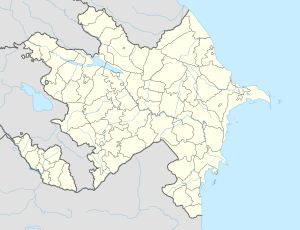Aza (until 2003,[1] Yuxarı Aza, Jukhary Aza, Yukary-Aza, and Yukhary Aza «Upper Aza») is a village and municipality in the Ordubad District of Nakhchivan, Azerbaijan. It is located on the left side of the Ordubad-Nakhchivan highway, 17 km southeast of the district centre, on the right bank of the Gilanchay River. Its population is busy with gardening, vegetable-growing, farming and animal husbandry. There are secondary school, club and a medical center in the village. It has a population of 442.[2]
Aza | |
|---|---|
Municipality | |
| Coordinates: 38°56′18″N 45°49′42″E / 38.93833°N 45.82833°E | |
| Country | |
| Autonomous republic | Nakhchivan |
| District | Ordubad |
| Population (2005)[citation needed] | |
• Total | 442 |
| Time zone | UTC+4 (AZT) |
Etymology
editThe former name of the village, Yuxarı (Upper) Aza means "Aza village which [is] located in the upper side"[citation needed]. In 2003, the name of the village was officially registered as Aza.[1] In the various sources, this settlement is described as a small town in versions of Aza, Azar, Azat, Azad[citation needed]. Two villages of Aza and Azadkand are now located in the same location.
Monuments
editThere was a ruinous Armenian church located on a hill to the west of the village.[3] The ruins of the church were completely destroyed by April 26, 2004.[3]
There was an Armenian cemetery located on the eastern edge of the village.[4] The cemetery consisted of 240–250 tombstones. The cemetery was destroyed by April 26, 2004.[4]
References
edit- ^ a b "Milli Meclis | Azerbaijan Parliament - renaming law". meclis.gov.az. Retrieved 28 February 2023.
- ^ ANAS, Azerbaijan National Academy of Sciences (2005). Nakhchivan Encyclopedia. Vol. I. Baku: ANAS. p. 46. ISBN 5-8066-1468-9.
- ^ a b Khatchadourian, Lori; Smith, Adam T.; Ghulyan, Husik; Lindsay, Ian (2022). Silent Erasure: A Satellite Investigation of the Destruction of Armenian Heritage in Nakhchivan, Azerbaijan. Cornell Institute of Archaeology and Material Studies: Ithaca, NY. pp. 188–191. Archived (PDF) from the original on 24 September 2022.
- ^ a b Khatchadourian, Lori; Smith, Adam T.; Ghulyan, Husik; Lindsay, Ian (2022). Silent Erasure: A Satellite Investigation of the Destruction of Armenian Heritage in Nakhchivan, Azerbaijan. Cornell Institute of Archaeology and Material Studies: Ithaca, NY. pp. 192–195. Archived (PDF) from the original on 24 September 2022.
External links
editSee also
edit- Azadkend — formerly, Aşağı Aza
